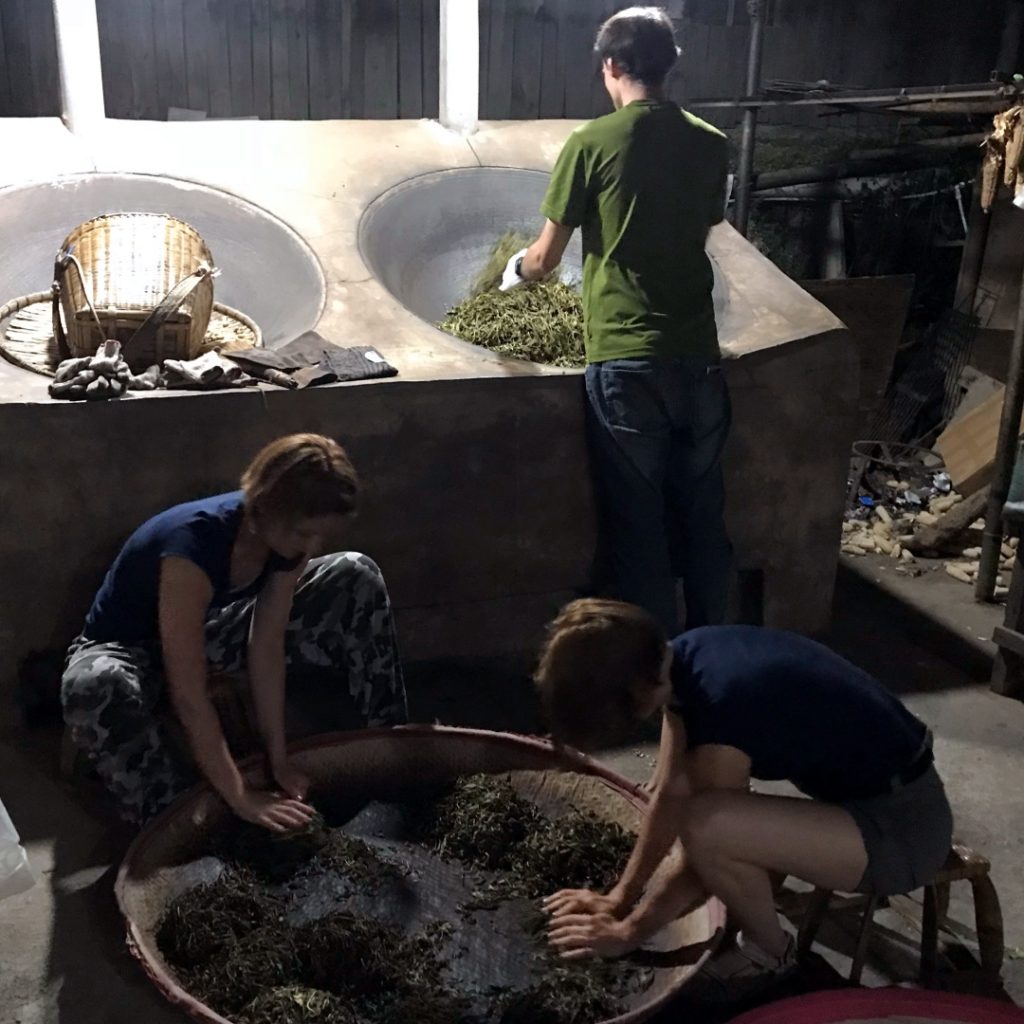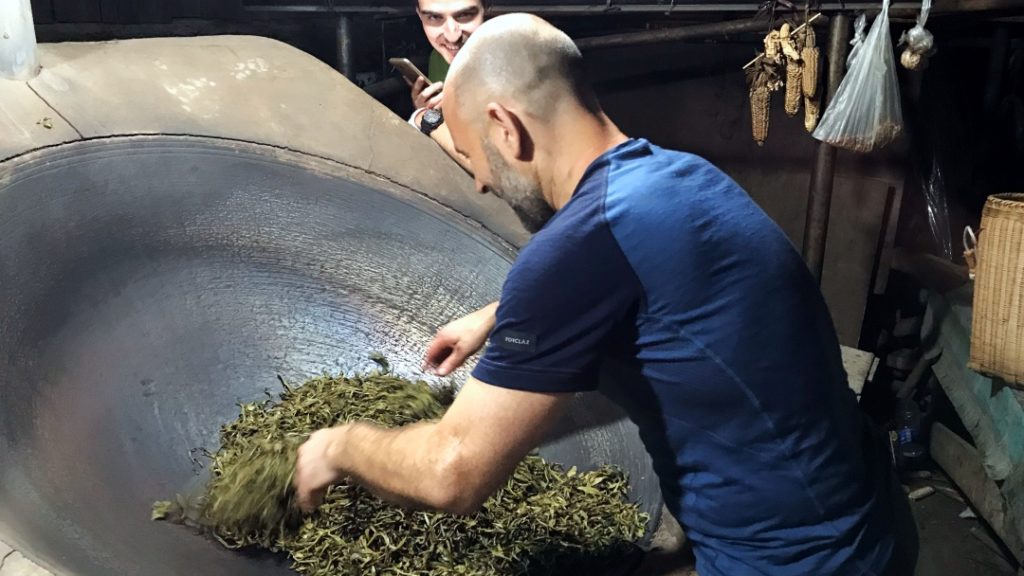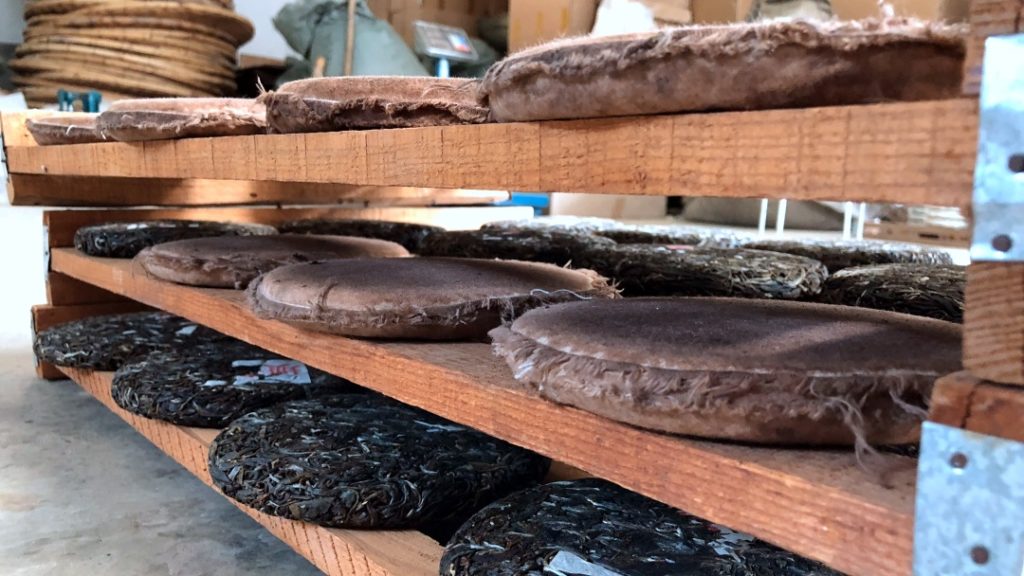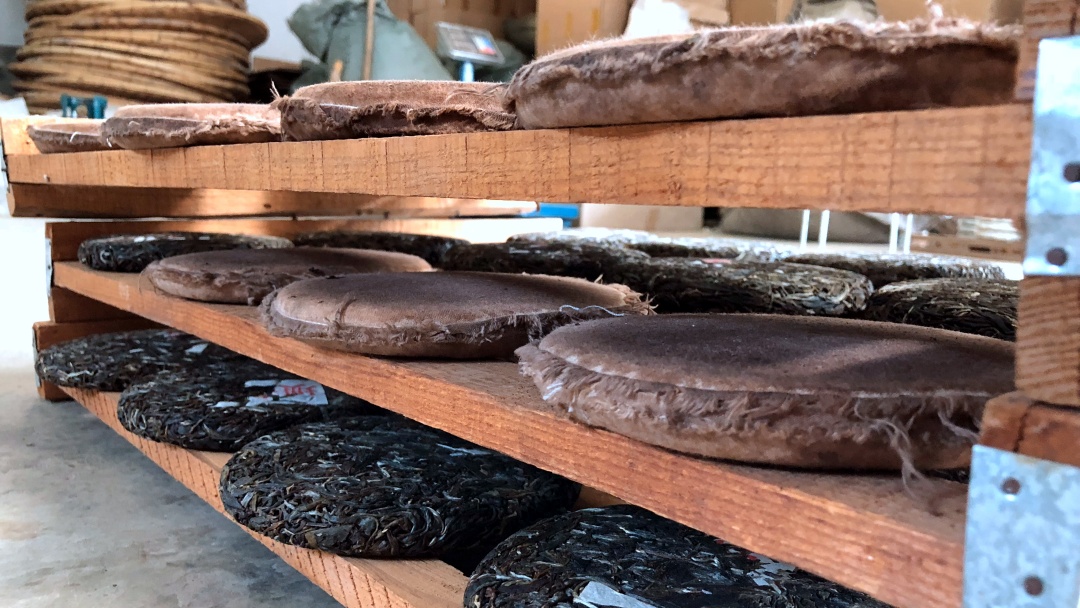A puer teáról röviden
A puer tea az utóérlelt teák kategóriájának egyik tagja, melyet a Kína, Yunnan tartományának déli részén, a Mekong folyó, a laoszi, vietnámi, burmai határ környékén készítenek.
A történetek szerint Puerh városáról kapta a nevét, mely a Tea-Ló út kereskedelmi útvonal fő állomása és központja volt.
(Sok írásmódot láthattok a tea nevét illetően: pu erh, pu er, puerh és a puer mind helyesek).
Két típusa ismert a feldolgozás módja szerint: Shu (fermentált, sötét) és a Sheng (nyers, zöld).
Az utóérlelt teák ahogy a nevük is jelzi, alkalmasak hosszú távú érlelésre, akár a fehér teák vagy a sütött oolongok.
Puer tea alapanyagának termesztése és készítése
- Teanövény típus: a yunnan-i nagy levelű fajta (Da Ye Zhong; Sinensis Assamica) és több alfajából kell, hogy készüljön
- Termőhely – Yunnan: Kína szabályozta, hogy mely területekről származó teát lehet puerként tekinteni, eredetvédett termék.
- Tealevelek szürete: Tavasszal, nyáron és ősszel is szedhetik a leveleket. A tavaszi és az őszi teák a legértékesebbek. Rügy; rügy+egy levél; rügy+két levél kombinációkban szedik.
Sheng és Shu – Melyik puer fajtát válasszam?
Sheng – “zöld puerh”
- Világos, nyers, zöld puer készítése (sheng): A leveleket néhány órán át napon szárítják, ezután nagyméretű wok-okban – enyhén megsütik. Utána kézzel sodorják: ezzel összetörik a sejtfalakat, hogy a levél belsejében lévő nedvesség felszabadulásával elinduljon a fermentációs folyamat, valamint felszínre kerüljenek a levél belsejében lévő íz és illatanyagok.
Pihentetik, majd újra szárítják. Az így elkészült tea neve „Mao Cha„, nyers tea, amit vagy szálas tea formában értékesítenek, vagy pedig préselni visznek. (Szálas formában gyorsabban érik mint préselt formában.) Préseléskora leveleket újra enyhén gőzölik, hogy megpuhuljanak, szövetbe csomagolják, majd súlyt helyeznek rá, vagy géppel préselik a kívánt formába.
Ezután indul az érlelési folyamat, hogy az érés során, az 15-20 év elteltével tovább alakuljon, érjen a tea. Egy jól elkészített és megfelelő alapanyagokból készülő Puernél az íz pozitív irányba történő változása akár több évtizedig is eltarthat.
A sheng puer ízvilága virágos, gyümölcsös, enyhén ásványos. Természetesen függ attól, hogy milyen teahegy teáját, melyik évből kóstoljuk, de általánosan elmondható ez a pár karakter. Ha alacsonyabb hőfokon készítjük el őket, gyümölcsösebbek, könnyedebbek lesznek, ha forróbb vízzel akkor kellemes fanyarságuk is előbukkan.
Sheng puer teáinkat itt találod meg
Shu – “sötét puerh”
- Sötét puer készítése (shu): A sötét puer feldolgozása a „Mao Cha” állapotig ugyanaz mint a sheng puernél. Innentől azonban változik a folyamat: gőzölés és formába préselés helyett „bedunsztolják„, azaz nedves környezetben halmokba rakják, letakarják, imitálva – és felgyorsítva – a természetes érési folyamatot.
A nedves nyersanyagot közben többször átforgatják gondosan átválogatják, hogy csak a legjobb minőségű tealevelek maradjanak benne és az érési folyamat alatt minden rendben menjen. Ez a folyamat 6 hónap-1 évig tarthat, gondos kezek és szakértő szemek felügyelete alatt.
A shu puer ízvilága földes, olajos és karakteres. Fermentált mivolta miatt sokaknak az őszi erdő jut eszébe róla. Sokszor datolyás, selymes és fűszeres. Nagy lelkesen javasoljuk, hogy kávé helyett fogyasszátok ezt a teatípust! Kíméletes a gyomornak, ébren tart úgy, hogy nem pörget túl és még finom, zamatos is.
Puer tea feldolgozásának lépései
A videókat Jingmai hegyen készítettük, Yunnan tartományban. A képen Balázs, Dóri, Era mellett William látható, aki kedves puer készítő barátunk. Feleségével együtt jó ideje készítenek ígéretes teákat, melyeket nálunk is meg tudtok kóstolni.
Puer tea készítés első lépései, a leszedett és fél napig puhult, fonnyasztott leveleket besütjük. A levelek oxidációját részlegesen megállítjuk.


A feldolgozott puerh alapanyag a “Mao cha” tea korongokká préselése
feldolgozott tea leveleket száradás után egy kicsit felpuhítják, hogy korongokká préseljék őket. A puerh tea korongok készítését láthatjátok a videóban.
Mao cha-nak, azaz nyers teának nevezik a teljesen feldolgozott és megszárított tealeveleket. Mindaddig így hívják, míg friss és nincs korong formába préselve. Minden teatípusnál a “félig kész” teákat nevezik így.
Puer tea rövid történelme
A puer készítés történelme egyes kutatók szerint 200 évvel Krisztus előttig, a Han dinasztiáig nyúlik vissza. Történelmi írások szerint a teát kisebbségi etnikumok készítették elsősorban saját fogyasztásra. Időnként Tibetbe, Mongóliába vagy Délkelet-Ázsiába exportálták, kereskedelmi árucikk volt.
Yunnan tartomány volt a híres „Lovas Tea Út” (茶 馬 古道) kereskedelmi útvonal kiindulópontja, ahonnan a teát Tibetbe és Észak-Kínába szállították. Második “Selyemútnak” tekintik.
A tealeveleket formába préselésnek (korong, tégla vagy fészekforma) praktikus oka volt: könnyebb volt így szállítani. Az utólagos fermentációt akkoriban az időjárási viszontagságok segítették elő, melyet Yunnan párás klímája és a gyakori csapadék segítette elő.
Shu Puer tea elterjedése – Miért olyan népszerű?
A gyorsított érlelés eljárás technikáját a híres kunming-i Meng Hai tea gyár fejleszette ki 1972-ben. Innentől kezdve ismerjük a Shu Puer fogalmát.
A tealevelek fermentálásának technikája már korábban is létezett, Kína más területein például a Guangxi tartományban, ahol a Liu Bao-nak nevezett fermentált teát már készítették.
A shu puernek a kialakulása azért vált szükségessé, mert az emberek megkedvelték az öreg, érlelt és érett teák ízét, melyhez kicsit hasonló ízvilágot 40-50 év után érhetnének el. Szükség volt egy “gyorsabb” folyamatra, mely kb. 3 hónap alatt lehetséges érlelt ízeket előcsalogatni.
A 2003-2004 -ben felfújódott „puerh-lufi” az árakat az egekig emelte, ekkor számos gyenge minőségű hamisítvány tea került a kínai piacra. Az ebből az időből származó teák továbbra is gyanúsnak számítanak és csak megbízható beszerzési forrásból érdemes vásárolni ezeket.
A főbb, híres és nagyobb tradicionális puer teagyárak: Menghai, Xiaguan, Kunming.
Újabb, jó hírnévre szert tett gyárak: Haiwan, Xing Hai, Changtai, Mengku, Nan Jian.
Shu Puer teát érdemes közepes és nagyobb teagyáraktól beszerezni, mivel ők rendelkeznek a biztonságos fermentáció minden eszközével.
Sheng puert viszont kisebb teakészítőktől, teafarmerektől. Mint a kisebb borászatok, együtt élnek a teával és kimagasló, személyes és jó energiájú teát készítenek.
Puerh tea elkészítése otthon – főbb paraméterek
Víz: Alacsony oldott ásványi anyag tartalmú, jó ízű, lágy víz (összes oldott ásványi anyag tartalom: 200mg/l alatt; PH 7 fölött) Ideális a forrásvíz (Lajos forrás) vagy a szűrt víz, amely esetleg magnéziummal pótolt..
Tealevél mennyisége: Az ázsiai elkészítési mód a legideálisabb a tea elkészítéséhez.
Nagyobb mennyiségű tealevél (5 – 7 gr) és kevesebb vízmennyiség javasolt (140 ml) rövid áztatási idővel (10-15 mp).
A préselt tealevelek szétválasztása: Puer tea bontásához való késsel, vagy egy erősebb, rövidebb (de nem túl éles) pengéjű késsel feszítsük szét a koronggá préselt leveleket. Legyünk nagyon óvatosak a teakorongok bontásakot.
Shu és Sheng puer tea készítése
A világos (sheng) puer leöntését alacsonyabb hőfokon javasolt kezdeni (85-90C) és a felöntések előre haladtával emelni a hőfokot. Gaiwanban (kínai fedeles csésze) érdemes a sheng puer teákat elkészíteni ha fiatalabbak, az idősebbeknek jól állnak a yixingi agyag kannák.
Az áztatási idő kb. 10 mp.
A sötét (shu) puer bírja a hőt és a hosszabb áztatást is, használjatok yixing agyag kannát az elkészítéséhez. Ezek jól tartják a hőt, és könnyű őket kezelni. A hőfok forráspontig emelhető, az áztatási idő itt is kb. 10 mp, melyet a felöntések előre haladtával emelhettek.
Fontos tudni! Ha sheng és shu puert is fogyasztunk, mindenképpen ügyelni kell a készítő eszközre. Ha porózus, agyag eszközt használnánk mindkettőhöz, ráadásul ugyanazt, ne tegyük! Az agyag “emlékező” tulajdonsága megjegyzi a pórusaiban az adott teatípust, így egy máz nélküli, agyag kanna csak egy teatípus készítésére alkalmas.
Teakészítéshez praktikusan tradicionális eszközöket használjatok, de a modernebbek közül is válogathattok, ha éppen az irodában, vagy gyorsan szeretnétek finom teát készíteni. Teakészítő eszközöket itt találtok.

Yixingi agyag kanna
3 év fölötti sheng puer teához és Shu Puer teához ideális választás a máz nélküli, porózus agyag kanna.
Jól tartja a hőt és a felöntések között is viszonylag állandó hőmérsékleten tudja tartani a tealeveleket.
Kicsi odafigyelésre szorul a kanna gondozása, de megéri kipróbálni és tea asztalunk állandó társává tenni, ha kedveljük a puereket, vagy éppen a sütött oolongokat.

Gaiwan
A legtökéletesebb teakészítő eszköz, a Kínában használatos gaiwan, azaz fedeles csésze.
Fiatalabb sheng és shu teák praktikus eszköze.
A puer egészségre gyakorolt hatása
Kínában a puer teát a népgyógyászat széles körben használja. Egy nehezebb étkezés után kiválóan segíti az emésztést a shu (érlelt) puer, illetve az öregebb, idősebb sheng puer teák.
Érdekes tanulmány a tea egészségre gyakorolt hatásairól itt és itt.
Milyen hatása van a Puer teának?
A kínai gyógyászat szerint jótékonyan hat a magas vérnyomás csökkentésére, a magas vércukorszintet is csökkenteni képes, illetve az emésztésre jótékony hatással van, főleg a gyorsított fermentáláson átesett Shu Puer teatípus.
Nehezebb ételek után emésztés segítésére, fejfájásra, illetve ébrentartásra igen hatásosnak bizonyult.
Bővebb információt a cikkben találsz.
Energizáló hatása miatt is sokan fogyasztják, kávé helyett ideális és egészségesebb megoldás. Bővebb információt a cikkben találsz.
Hogyan készítsem el a Puer teát?
Javasolt az ázsiai arányokkal és készítési módszerrel elkészíteni a Puer teákat.
Shu Puer elkészítése: (Gyorsított fermentáláson átesett tea) Tradicionális módon 4 gr tealevelet használjatok 100 ml vízhez. Ettől természetesen eltérhettek, egyéni ízlésetek szerint, de azoknak, akik még nem fogyasztottak ilyen teát, ezzel az aránnyal kezdjék.
Szóval. 4 gr tealevél / 100 ml víz. A víz 100 C-os legyen, egy gyors ébresztést követően többször felönthetjük. Az áztatási idők kb. 20-30 mp-esek legyenek.
Sheng puer elkészítése: 85-90 fokos vizet használjatok ha fiatalabb sheng Puer teával van dolgotok. A víz és tealevél arány a shu pueréhez hasonlatos.
Nyugati módon is elkészíthetitek. Ekkor 5 gr tealevél, 200-300 ml 95C°-os vizet használva és 1 percig áztatva az ideális. Bővebb információt a cikkben találsz.
Mi a puerh tea?
 A puer tea a szubtrópusi klímájáról is híres Yunnan tartomány teája, mely természetes vagy gyorsított eljárással fermentált teatípus. Kritériuma még, hogy az itt honos nagylevelű teanövény fajtából készítik és általában korong formájúvá préselik. Bővebb információt a cikkben találsz.
A puer tea a szubtrópusi klímájáról is híres Yunnan tartomány teája, mely természetes vagy gyorsított eljárással fermentált teatípus. Kritériuma még, hogy az itt honos nagylevelű teanövény fajtából készítik és általában korong formájúvá préselik. Bővebb információt a cikkben találsz.

Ennyi időt vesz igénybe a teljes teakészítési folyamat 3 perc.
Hogyan készítsem el a puerh teát?
- Tealevelek kiméréseHa puerh korongot vásároltál valamelyik tea szakboltban, volt szerencséd látni, ahogyan egy puerh bontó kés segítségével szétvágják neked a kért mennyiségű korongot. Ebből törj le egy teázásnyi adagot, mely ízlésenként eltérő lehet.
- Tealevelek áztatási idejeNyugati mód szerint: 5,5 gr puer tea, 350 ml eszközben és 100 C-os vízzel felöntve áztasd 2 percig, majd szűrd le. Megismételhetjük a felöntést még 1x.
Az áztatási idő szintén 2 perc legyen.
Ázsiai mód szerint 5,5 gr tealevél 120 ml-es kannában és 100 C-os vízzel felöntve. Gyors ébresztés után 30-60 mp közötti felöntési időkkel számolva készítsük a teánkat.
Többször fel lehet önteni a leveleket.

